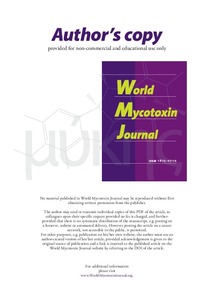| dc.contributor.author | Garrido-Bazan, V. |
| dc.contributor.author | Mahuku, George S. |
| dc.contributor.author | Bibbins-Martinez, M. |
| dc.contributor.author | Arroyo-Bacerra, A. |
| dc.contributor.author | Villalobos-López, M.A. |
| dc.date.accessioned | 2019-12-04T11:21:01Z |
| dc.date.available | 2019-12-04T11:21:01Z |
| dc.date.issued | 2018 |
| dc.identifier.citation | Garrido-Bazan, V., Mahuku, G., Bibbins-Martinez, M., Arroyo-Bacerra, A. & Villalobos-López, M.Á. (2018). Dissection of mechanisms of resistance to Aspergillus flavus and aflatoxin using tropical maize germplasm. World Mycotoxin Journal, 11(2), 215-224. |
| dc.identifier.issn | 1875-0710 |
| dc.identifier.uri | https://hdl.handle.net/20.500.12478/3636 |
| dc.description | Published online: 10 April, 2018 |
| dc.description.abstract | Aspergillus flavus induced ear rots and subsequent contamination of maize (Zea mays L.) by aflatoxin is a serious food safety issue, especially in developing countries where the crop is mostly cultivated by smallholder famers for own consumption and income generation. A better understanding of the mechanisms of resistance could help breeders to develop resistant maize varieties. In this study, a set of six tropical maize inbred lines previously identified as resistant or susceptible under natural field conditions were evaluated for response to A. flavus colonisation and aflatoxin contamination. Fungal biomass was significantly higher (P<0.05) in susceptible than resistant maize inbred lines, and this was highly correlated (P=0.001) to aflatoxin levels. Maize inbred lines MRI, MR2 and MR3 had low fungal biomass and low aflatoxin levels, suggesting that resistance in these lines was mediated through restricted fungal colonisation and establishment. Among the three putatively resistant inbred lines mentioned above, MR2 had a relatively high colonisation compared to the other two lines, revealing that A. flavus could establish and colonise kernels that were injured during inoculation, but did not contain high levels of aflatoxin. This could signify the presence of host genes that interfere with the aflatoxin biosynthetic pathway. |
| dc.description.sponsorship | Bill & Melinda Gates Foundation |
| dc.format.extent | 215-224 |
| dc.language.iso | en |
| dc.subject | Maize |
| dc.subject | Aspergillus Flavus |
| dc.subject | Aflatoxins |
| dc.subject | Resistance |
| dc.subject | Food Security |
| dc.title | Dissection of mechanisms of resistance to Aspergillus flavus and aflatoxin using tropical maize germplasm |
| dc.type | Journal Article |
| dc.description.version | Peer Review |
| cg.contributor.crp | Agriculture for Nutrition and Health |
| cg.contributor.affiliation | Instituto Politécnico Nacional, Mexico |
| cg.contributor.affiliation | International Maize and Wheat Improvement Center |
| cg.contributor.affiliation | International Institute of Tropical Agriculture |
| cg.creator.identifier | George Mahuku: 0000-0001-8444-8651 |
| cg.isijournal | ISI Journal |
| cg.authorship.types | CGIAR and developing country institute |
| cg.iitasubject | Maize |
| cg.journal | World Mycotoxin Journal |
| cg.howpublished | Formally Published |
| cg.accessibilitystatus | Limited Access |
| local.dspaceid | 95702 |
| cg.targetaudience | Scientists |
| cg.identifier.doi | http://dx.doi.org/10.3920/wmj2017.2219 |

